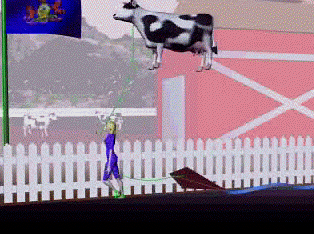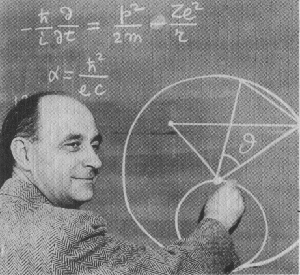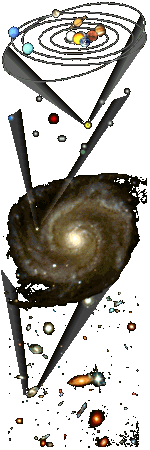Problem-Solving
Larry Gladney is Associate Professor of Physics and Dennis DeTurck is Professor of Mathematics, both at the University of Pennsylvania.
While the focus of these modules in Math and Physics is on conceptual learning, a great deal of the "utility" of introductory courses in calculus and physics is in developing problem-solving skills. Hence any textbook has many traditional examples of problems and many more exercises for the student than are presented within these modules.
A proper introduction to problem-solving starts by being reminded that the essence of scientific progress since Galileo is in experimenation and experimentation is founded on quantitative measurement.
As an example, consider the pictures below. They show two scenes of a girl walking a cow to pasture while simultaneously holding a kite on a windy day. Which of the two scenes are you more likely to see on a March day in Pennsylvania farmland?
 |
 |
Published July 2001
© 2001 by Larry Gladney and Dennis DeTurck
Problem-Solving - Introduction
Larry Gladney is Associate Professor of Physics and Dennis DeTurck is Professor of Mathematics, both at the University of Pennsylvania.
While the focus of these modules in Math and Physics is on conceptual learning, a great deal of the "utility" of introductory courses in calculus and physics is in developing problem-solving skills. Hence any textbook has many traditional examples of problems and many more exercises for the student than are presented within these modules.
A proper introduction to problem-solving starts by being reminded that the essence of scientific progress since Galileo is in experimenation and experimentation is founded on quantitative measurement.
As an example, consider the pictures below. They show two scenes of a girl walking a cow to pasture while simultaneously holding a kite on a windy day. Which of the two scenes are you more likely to see on a March day in Pennsylvania farmland?
 |
 |
Published July 2001
© 2001 by Larry Gladney and Dennis DeTurck
Problem-Solving - Units and Dimensional Analysis
To Measure All Things

Modern science begins with observation and description. The appropriate means of description should allow for little ambiguity in comparison of observations from different people. In many ways, science is more of a driver for a ``universal'' language than almost any human activity. Although mathematics suffices as a universal language for theoretical purposes, when it comes to experimental measurement, we turn to a globally agreed upon set of standards termed SI or Système International.
The SI units for length, mass, and time are the
-
 meter
meter -
 kilogram
kilogram -
 second.
second.
Combinations of these basic units are used to make up other SI units for quantifying energy, power, speed, force, etc. The SI units all make use of the same set of prefixes for specifying appropriate powers of ten of the basic unit. For example, the centimeter is 1/100 of a meter, a kilometer is 1000 meters, etc. The list of accepted prefixes is below.
| Factor | Prefix | Symbol |
|---|---|---|
| 1018 | exa | E |
| 1015 | peta | P |
| 1012 | tera | E |
| 109 | giga | G |
| 106 | mega | M |
| 103 | kilo | k |
| 102 | hecto | h |
| 101 | deca | da |
| 10-1 | deci | d |
| 10-2 | centi | c |
| 10-3 | milli | m |
| 10-6 | micro | µ |
| 10-9 | nano | n |
| 10-12 | pico | p |
| 10-15 | femto | f |
| 10-18 | atto | a |
All calculations you do for this class should be in terms of SI units. It will not always be necessary to use SI units to get the correct answer, but all of the formulas we use assume that you are using SI units and are defined with that in mind.
Conversion Between Units
Dealing with units can be annoying when it is necessary to transform from one set to another. You will find below a handy interactive conversion table for doing just that.
In terms of operation, we generally will need to simply multiply through by appropriate conversion factors in a calculation to get to the standard units, for example, suppose we need to find the speed of a car in m/s for a particular problem, but the statement of the problem gives the speed as 30 miles/hour. Then, we perform the following operation by getting the conversion factors from the unit conversion program, then
Another useful reason for keeping track of units is that they generally give the first hint that a numerical error may have occurred in your calculations. Generally, converting from one unit to another, a technique termed dimensional analysis, is a necessary part of the calculation of an answer to a problem, hence if the units do not come out correctly, you can be sure that there is something not right with your solution. Another thing to watch for is reasonableness of the answer. Physics classes generally provide problems with answers that are actually realizable in real life. Cars do not travel 8000 miles/hour, people can't apply 4 million pounds of force to a door. If the numbers don't look like they fit the size of the unit, check your calculation!
If you haven't done it in awhile, you will need to practice a bit with unit conversions. Let's try the following exercises, using the conversion tables that you can access with the following link.
Distance and Weight Conversion Calculators
Problems
-
Ten pounds of flour correspond to how many kilograms of flour?
-
A car driving at 65 miles/hour is travelling at what speed in meters/second?
- What is the value of X that is necessary to convert A, in units of centimeters/fortnight to B where B is feet/century?
Problem-Solving - Significant Figures
Dimensions of Physical Quantities

When dealing with calculations of physical quantities, we need to be careful to not add "apples and oranges". The following table gives the dimensions for various physical quantities with L standing for a dimension of length, m for mass, and t for time. We will come across all of these in this course of study.
|
In order to do any mathematical operation (add, divide, multiply, or subtract) with any of these physical quantities, we must be sure that all the physical quantities involved in the operation are of the same type. For example, it is wrong to do the operation
if A is a velocity and B is a force. The dimensions for C would be undefined. Many great ideas in physics were begun on the basis of making calculations that were dimensionally correct. For example, physicists had noted that two of the fundamental constants in physics that determine the strength of electric and magnetic interactions, when multiplied gave units which were the inverse square of a velocity. The precise number was exactly equal to the inverse square of the speed of light in fact. This was the first hint of a deep connection between what appeared to be very different physical phenomena: electricity, magnetism, and optics.
Dimensional analysis is also one of the methods for determining whether some error has occurred in the midst of a calculation since units must be consistent at all points.
Significant Figures and Scientific Notation
All physical measurements are limited by intrinsic uncertainties in the method by which they are made. Even in the ideal exact measurement is not possible since ultimately quantum mechanics imposes fundamental limits on what we can quantitatively know about a system. Since the measurement technique determines the uncertainty in the measurement, quantitative sciences ONLY deal with measurements which are accompanied by the associated uncertainty. Hence it is never appropriate to state the result of a laboratory measurement as, say 3 centimeters. We are required to state the uncertainty as part of the measurement, e.g. 3 ± 0.2 cm. The 0.2 cm indicates that we can have made an error of as much 0.2 cm in the measurement of 3 cm so someone else making the measurement with a similar or more accurate instrument might get a value as low as 2.8 cm (but not likely a lower value) or a number as high as 3.2 cm (but not likely a higher value).
In making calculations, we need to keep in mind that the significant figures are determined by the last digit (other than the zeroes used to locate the decimal point) which is believed reliable. Hence, if our measurement of a speed is accurate to within 5 mm/s then we would state a measurement of speed in meters per second with 2 decimal places after the decimal point as in 4.52 m/s. A third decimal place after the decimal point would not be reliable as it could be off by as much as ± 5. The number of significant digits is determined by the number of digits which are reliable, therefore 4.52 has 3 significant figures. A number such as 121.83 has five significant figures and 0.00012 has two significant figures since the zeroes before the "12" only locate the decimal point.
As a matter of convenience for writing and a means of emphasizing the significant figures of a measurement, we use scientific notation for numbers. This notation states numbers as a product of a number and a power of 10. For example, the number 0.00012 in scientific notation would be stated as
We can apply a combination of significant figures, scientific notation and unit conversions to a typical problem.
Example: The SI unit of volume is the liter, defined as the volume that fits in a cube 10 cm along each dimension. What is the density of water (in g/cm3) if 2200 pounds occupies a volume of 1000 liters?
Solution:
Use the unit conversion tools as needed.

Problems:
-
There are 640 acres in a square mile. How many square cm are there in one acre?
-
Calculate the following rounded off to the correct number of significant figures. Express your result in scientific notation
- (1.14)(4.998 × 106)
- 3p/(8.96 × 106)
- 2.78 × 10-8 - 5.698× 10-9
- 42.1683 + 0.332
-
Complete the following calculations with the appropriate scientific units and notation. (You may need to refer back to the section 2 on units.)
- power of a nuclear reactor = (103kg) (4.23 × 106 m2/s3)
- lifetime of a subatomic particle (the muon) = (8.36 cm)/(3.8 × 104 m/s)
- mass of the earth = (1.96 × 1030 J)/ (572.5 m/s)2
Problem-Solving - Estimation and Orders of Magnitude

Developing a good sense of how to use your physical intuition for solving problems involves learning the technique of deciding which approach to solving a problem tends to work more "easily" than other possible approaches. In some cases, detailed mathematical analysis is necessary, but, for many questions, an amazing degree of accuracy can be obtained by a series of "educated guesses" for which the correct order of magnitude for each quantity involved and simple calculations are all is all that is necessary to get a surprisingly accurate answer. The great nuclear physics Enrico Fermi is acknowledged as one of the great masters of this technique and used it to find the answers to what would seem to be almost impossible questions to answer. Hence the kind of problems that can be attacked in this way are termed Fermi problems. Here are some examples:
Example 1:
What thickness of rubber tread is worn off of the tire of a typical automobile as it travels one mile?
Solution:
We could answer this question if we knew the following information:
- The thickness of tread on a new tire.
- The average distance of driving before a tire typically needs to be replaced.
- New tire tread thicknesses are about 1 inch. They may actually be 2 inches or 0.5 in, but an order of magnitude accuracy is "good enough". Certainly 0.1 inch is too small and 10 inches is too thick.
- Typically tires will last about 40,000 miles. Again, the answer for some tires might be 30,000 miles and longer-wearing tires might be 60,000 miles, but you would find it hard to afford a car if the tires needed to be changed every 4,000 miles and very few people would ever need to buy tires if the answer was 400,000 miles.
|
|||||||||||||||||||||||||||||||||||||
Although our answer may be off by a factor of 2 or 3, it is almost certainly not off by a factor of 10. For some problems this is more than adequate.
Example 2:
Fans of a college football team are excited after their team wins the game. They rush onto the field. How many people can fit onto the field of 100 yards by 50 yards?
Solution:
Start by assuming that each person needs an area of about 18 inches by 12 inches if they are packed as closely as possible. Then, we would have
So 30,000 people can fit onto the field itself.
Sometimes you can use the Fermi method to get some amazingly accurate results from your everyday knowledge. For example, suppose you are asked to state the radius of the earth and you do not have that quantity handily available. Think about your (or others) travel experiences:
- If you fly across the United States, how many time zones do you cross? Answer: 3.
- What is the average distance across the US? Answer: about 3000 miles.
- So, on average, there are about 1000 miles of distance traveled per time zone.
- There must be 24 time zones around the earth in all since there are 24 hours in the day so the earth circumference must be about 24,000 miles.
- The circumference of a circle is 2pr where r is the radius so
The actual answer is 6.37 x 106 m so you can see that the Fermi estimate gets remarkably close.

Although the breadth of the Internet and smart search engines have made it possible to quickly find incredible amounts of information, it is still useful to keep in mind some orders of magnitude for how big or small things are for just the kind of quick Fermi problem calculations we might use to decide how to attack particular problems. Here are a few quantities that might prove useful along with the Web links to where the information was derived. You may wish to explore these links at your leisure, but it is not necessary to do so. These links were valid as of Jun 1, 2001. [Editor's note: Links checked Nov 8, 2004.]
| Type | Numerical value | Web link |
|---|---|---|
| World population (1999): | 6.032 x 109 (estimated: 12/20/99) | US Census Bureau |
| US population (1999): | 2.74 x 108 (estimated: 12/20/99) | US Census Bureau |
| World Population (1650): | 5 x 108 | Brockport HS Science Dept. |
| Power of a hurricane | 2 x 1013 W | Brockport HS Science Dept. |
| Height of Mount Everest | 8,850 m | Infoplease Everest Almanac |
| Length of a typical virus | 10-8 m | Tulane University |
Problems:
- How long would it take for you to walk from Los Angeles to Philadelphia?
- How many dice would it take to fill a typical football stadium?
- Each binary digit on a computer is called a bit. A series of eight bits forms a byte. A CD-ROM holds 650 megabytes of information. Estimate the number of typical books that can be stored on a CD-ROM.